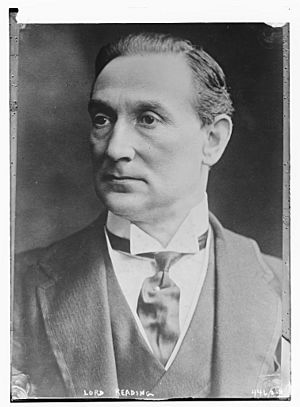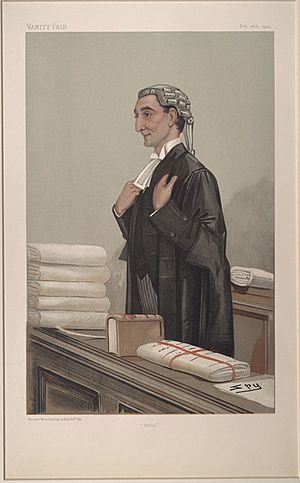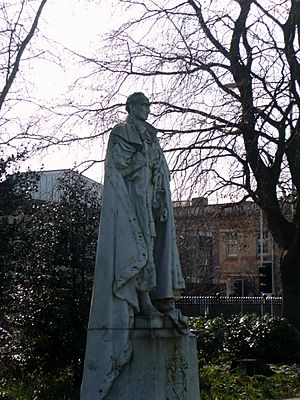Rufus Isaacs, 1st Marquess of Reading facts for kids
Quick facts for kids
The Most Honourable
The Marquess of Reading
|
|
|---|---|

Reading in 1917
|
|
| Leader of the House of Lords | |
| In office 25 August 1931 – 5 November 1931 |
|
| Monarch | George V |
| Prime Minister | Ramsay MacDonald |
| Preceded by | The Lord Parmoor |
| Succeeded by | The Viscount Hailsham |
| Secretary of State for Foreign Affairs | |
| In office 25 August 1931 – 5 November 1931 |
|
| Monarch | George V |
| Prime Minister | Ramsay MacDonald |
| Preceded by | Arthur Henderson |
| Succeeded by | Sir John Simon |
| Viceroy and Governor-General of India | |
| In office 2 April 1921 – 3 April 1926 |
|
| Monarch | George V |
| Prime Minister | |
| Preceded by | The Lord Chelmsford |
| Succeeded by | The Earl of Halifax |
| Lord Chief Justice of England | |
| In office 21 October 1913 – 8 March 1921 |
|
| Monarch | George V |
| Preceded by | The Viscount Alverstone |
| Succeeded by | The Lord Trevethin |
| Attorney-General for England | |
| In office 7 October 1910 – 19 October 1913 |
|
| Monarch | George V |
| Prime Minister | H. H. Asquith |
| Preceded by | Sir William Robson |
| Succeeded by | Sir John Simon |
| Solicitor-General for England | |
| In office 6 March 1910 – 7 October 1910 |
|
| Monarch | Edward VII George V |
| Prime Minister | H. H. Asquith |
| Preceded by | Sir Samuel Evans |
| Succeeded by | Sir John Simon |
| Member of the House of Lords Lord Temporal |
|
| In office 9 January 1914 – 30 December 1935 Hereditary Peerage |
|
| Preceded by | Peerage created |
| Succeeded by | The 2nd Marquess of Reading |
| Member of Parliament for Reading |
|
| In office 6 August 1904 – 19 October 1913 |
|
| Preceded by | George William Palmer |
| Succeeded by | Leslie Orme Wilson |
| Personal details | |
| Born |
Rufus Daniel Isaacs
10 October 1860 Tower Hamlets, London, England |
| Died | 30 December 1935 (aged 75) Mayfair, London, England |
| Political party | Liberal |
| Spouses |
Alice Edith Cohen
(m. 1887; died 1930) |
| Children | Gerald Isaacs, 2nd Marquess of Reading |
| Education | University College School |
| Profession | Lawyer, jurist, politician |
Rufus Daniel Isaacs, 1st Marquess of Reading (born October 10, 1860 – died December 30, 1935), was a very important British politician and judge. He was also known as The Earl of Reading for some years. He held many high-ranking jobs, including the top judge in England (called the Lord Chief Justice), the leader of British India (called the Viceroy of India), and the person in charge of foreign relations (called the Foreign Secretary). He was the last Liberal Party member to be Foreign Secretary.
Rufus Isaacs was also special because he was the first Jewish person to become Lord Chief Justice. He was also the first, and so far only, Jewish person in Britain to be given the very high title of a marquess.
Contents
Early Life and Family
Rufus Isaacs was born in London, England. His father was a Jewish fruit importer. Rufus went to University College School. When he was 15, he started working in his family's business. He even worked as a ship's boy for a year! Later, from 1880 to 1884, he worked on the stock market, helping to buy and sell shares.
In 1887, he married Alice Edith Cohen. She had a long-term illness and sadly passed away from cancer in 1930. They were married for over 40 years. A hospital in Peshawar was named after her.
After Alice died, Rufus married Stella Charnaud in 1931. She had been Alice's secretary. Their marriage lasted until Rufus passed away in 1935. Stella Isaacs also became a very important person later in her life.
Becoming a Lawyer
Rufus Isaacs started studying law in 1885. He became a lawyer in 1887. He quickly became very successful. Within five years, he was able to pay off any money he owed. After 20 years, he was earning a huge amount of money each year.
In 1898, he became a Queen's Counsel. This is a special title for very experienced lawyers. He was known for being calm and smart in court. He worked very hard, preparing his cases early in the morning.
Working in Politics
Rufus Isaacs first tried to become a Member of Parliament (MP) in 1900 but didn't win. However, in 1904, he was elected as an MP for Reading. He held this seat for nine years.
In 1910, he became the Solicitor General, a top legal job for the government. He was also made a knight, so he became "Sir Rufus Isaacs." Just six months later, he was promoted to Attorney General. This was an even higher legal role. He was the first Attorney General to be part of the Cabinet, which is the group of most important government ministers.
As a government lawyer, he handled many big cases. He helped create important laws like the Parliament Act 1911 and the National Insurance Act 1911. He also helped investigate the sinking of the famous ship, the RMS Titanic.
Becoming a Judge and Diplomat
In 1913, Rufus Isaacs became the Lord Chief Justice of England. This is the highest judge in England. He was also given the title Baron Reading.
Even though he was a judge, the government often asked him for advice. When World War I started in 1914, he helped deal with money problems. In 1915, he went to the United States to get financial help for Britain and its allies.
In 1917, he was sent to the United States and Canada as a special representative. In 1918, he became the British Ambassador to the United States. This meant he was Britain's main representative in America. He held this job while still being Lord Chief Justice! For his important work during the war, he received even higher titles: Viscount Reading in 1916 and Earl of Reading in 1917.
Leading India
In 1921, he left his judge job to become the Viceroy and Governor-General of India. This was a very powerful role, like being the leader of British India. He wanted to be fair and end unfair treatment based on race. He met with important Indian leaders like Mohandas Karamchand Gandhi and Muhammad Ali Jinnah. He also visited Amritsar to show he wanted peace.
However, he sometimes had to use force to keep order. For example, he ordered the stopping of the Malabar rebellion in 1921. In 1922, he had Gandhi arrested for speaking out against the government. He also worked well with Indian princes, but he made two maharajas (Indian rulers) give up their power.
When he returned from India in 1926, he received the highest title of all: Marquess of Reading. He was the first person to rise from a regular citizen to a marquess since the famous Duke of Wellington.
Later Life and Work
After his time in India, Rufus Isaacs joined the boards of several companies. He became the president of Imperial Chemical Industries, a large chemical company. From 1931 to 1935, he was the leader of the Liberal Party in the House of Lords.
He also took part in important meetings about the future of British India. In 1931, he briefly served as the Foreign Secretary and the Leader of the House of Lords in the government. However, he had to step down due to poor health.
In 1934, he was appointed Lord Warden of the Cinque Ports, another important historical role.
Death and Legacy
Lord Reading passed away in London in December 1935 at the age of 75. His ashes were buried in a Jewish cemetery. The house where he died has a special blue plaque on it to remember him.
He received many awards and honors throughout his life. He was given five different noble titles and five knighthoods. He also received honorary degrees from many famous universities around the world.
Even though he didn't have a clear connection to Canada, a law society for Jewish lawyers in Quebec was named in his honor. A power station in Tel Aviv, Israel, called the Reading Power Station, was also named after him.
Rufus Isaacs believed in fairness and progress. He supported ideas like taxing land values and improving laws for workers' unions, education, and social insurance. He was a strong supporter of the Liberal Party because he believed it stood for freedom, tolerance, and progress.
Images for kids
-
Mr. Lloyd George, Lord Reading and M. Albert Thomas visiting the Front in France.





